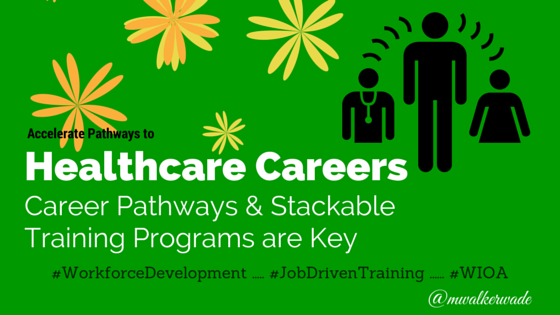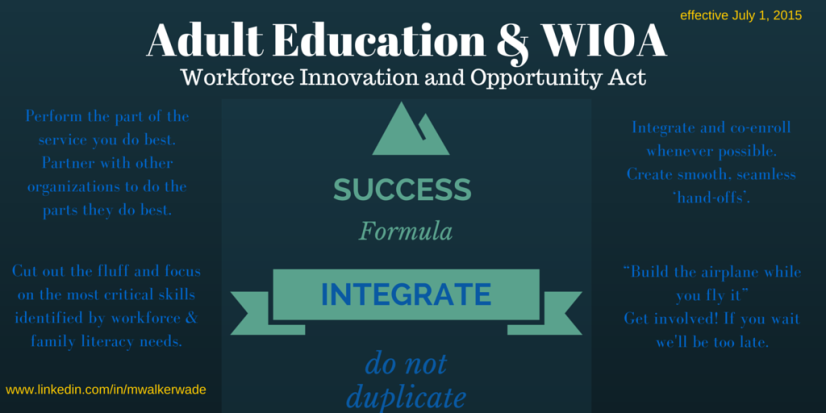Archive
Creating Accelerated Career Pathways into Healthcare
 According to Manpower’s 2015 Talent Shortage Survey (#TalentShortage), nursing occupations is #7 on a list of 10 industries. For survey purposes, nurses includes:
According to Manpower’s 2015 Talent Shortage Survey (#TalentShortage), nursing occupations is #7 on a list of 10 industries. For survey purposes, nurses includes:
Non-degree: CMAs, PCAs, CNAs, HHAs, LPNs, and LVNs
Degreed: RNs
Advanced degree: APNs, NPs, PAs, CLNs, CNSs, CNMs, CRNAs
According to Stephanie Neuvirth, chief human resources and diversity officer at City of Hope in Duarte, CA:
“Jobs in accounting, finance, IT and administration are plentiful in health care. Although these jobs provide the infrastructure for the health care industry, parents, guidance counselors and students don’t realize they exist.”
Career fields such as healthcare, especially where patient contact is key, are challenging to fill because success depends on having the right combination of soft skills, technical skills, and physical ability. Certain roles in health care also needs individuals who are able to relate to the cultural and spiritual norms of the patient. Healthcare providers in Duarte, CA understand this challenge all too well, as 71% of their patients are Hispanic.
“Only 6 percent of the physicians and 8 percent of the nurses in the U.S. are Hispanic”
When I look across the landscape of career education, I see many schools providing training in allied healthcare, yet employers still struggle to get the type of employee they really need. It’s clear that the typical training program is not quite hitting the mark. In some cases the problem is the curriculum, in other cases the problem is access to internships, but in some cases (and I hate to say this) it’s the student. I’ve had first-hand experience on numerous occasions where a student wanted to join my healthcare training program because “there’s a lot of jobs in healthcare”. As a program manager, if your primary concern was getting enough students enrolled into the course to meet your revenue target, it may be easy to fill your class with students who can do the technical skills of medical care, but who lack the genuine compassion for patient care. These type of students will ultimately be fairly unemployable in the healthcare industry. As workforce development planners and education & training providers I believe this is something that deserves our consideration.
There are three programs making an impact on suring-up our need for qualified and quality health care talent I’d like to share with you:
CareerSTAT is “an initiative to document and endorse the business case for investments in frontline hospital workers and to establish an employer-led advocacy council to promote investments that yield strong skill development and career outcomes for low-wage, frontline hospital workers”. Nearly 100 health care organizations partner with CareerSTAT including Kaiser Permanente and Banner Health. Some of their activities include:
- An employer-led national collaboration of health care leaders
- A clearinghouse for best practices in health care and shared information in training development
- A focus on early college and career pathway programs and provides low-income and minority students with access to in-demand health care careers
- Work towards initiatives that would get Hispanic youth engaged in health care careers
TEACH Project (Train, Educate, and Accelerate Careers in Healthcare)- seeks to create skilled workers in health IT. This project works with high-school students to provide education, training and job shadowing opportunities, integrated with their current school studies. Students concurrently receive high-school credit, community college credit, and on the job experience that accelerates their entrance into a job in the medical field.
Homebridge, Inc in San Mateo, CA – One of the most advanced employer-based, entry-level training programs into the medical field. The Homebridge training program provides adult-centered, competency- based training curriculum, designed to be accessible to students with a minimum of 6th grade proficiency. The training highlights the value of hands-on learning and includes a simulation apartment where caregivers can practice with beds, wheelchairs, and bathroom facilities. Success in the classroom is supported in the field by peer mentors who provide on- the-job training and a work-life coach who addresses barriers to job retention. Because of their strong emphasis on training & development, Homebridge’s 37% turnover rate for frontline caregivers is 31% lower than the 54% national average.
As workforce developers and education & training providers move forward with WIOA (Workforce Innovation & Opportunity Act) implementation activities, I believe programs like these give great models to emulate, but more so, some good starting points for finding the right kind of partnerships. Remember, partnerships and “stackablity” are key components to a successful WIOA funded program.
This article is based on my own research, therefore I have no endorsement of any kind from these three programs. If you’d like to read more about them you’ll find articles at these two links.
CareerSTAT & TEACH – http://tinyurl.com/p8vjymn
Homebridge, Inc: http://tinyurl.com/o88rjsf
Introducing the America’s College Promise Act 2015 (H.R. 2962)
On July 8, 2015 the House and Senate introduced the America’s College Promise Act 2015. This act would make up to two years of community college tuition-free for up to 9 million qualifying students. Funding could cover 100% of in-state tuition and fees (75% covered by Federal funding, 25% by State funding).
Eligible students:
- Must be enrolled in an eligible program at a community college for the first time
- Must attend college on at least a half time basis
- Must also maintain satisfactory progress in their course of study
- Must enroll in:
- academic programs that fully transfer to a bachelor’s or graduate degree at any public college or university in the state
- occupational skills training programs that lead to a recognized postsecondary credential in an in-demand industry sector or occupation in the state
The bill includes funding for community college, technical college, tribal colleges and historically black colleges and minority serving institutions.
It’s important to note:
- The Federal will provide $3.00 for every $1.00 of State funding.
- States’ must agree to participate.
- If a State opts-in, colleges must also commit to certain education reforms aimed at improving the quality of the educational experience and its outcomes.
- This act is in effort to build a strong workforce and global economy.
- Thus far, this act is not a bi-partisan effort. It was introduces by the democrats with 61 sponsors.
- With regards to community college, because this funding only applies to academic courses that are transferable to a 4-year institution, it cannot be used for remedial and/or non-transferable pre-requisite college courses.
As of July 2015, this act has not yet passed. It’s simply been ‘introduced’.
Click here and listen to an audio recording of the live press release.
A recent poll indicated nearly 70% of Americans oppose free community college. Based on the requirements introduced in this bill, what are your thoughts? Yay or nay?
Adult Literacy Education Providers Prep for WIOA’s Integrated Education and Training pt 2
THE WIA-TO-WIOA TRANSITION BEGINS JULY 1, 2015
THE UPCOMING ACADEMIC YEAR IS A YEAR OF CHANGE
In 2012 the U.S. Department of Education Office of Vocational and Adult Education produced a 30-page document titled: Promoting College and Career Readiness: Bridge Programs for Low-Skill Adults. If you read through it, you will see very sharp resemblances of what we as Education & Training professionals should be focusing on to gear up for WIOA changes on our campuses and in our classrooms. Some of the terms in the report vary from the terms in the WIOA proposal, but the meanings are the same.
♦♦♦ I will highlight some of the report’s content below ♦♦♦
Create bridge programs (“Pathways”) to help adult students identify career and education goals and develop the skills, content knowledge, and learning strategies needed to enter and succeed in postsecondary education and employment.
Combine (“Integrate”) basic skill instruction in reading, math, writing, and English language, including preparation for the GED test, employment skills, and college success strategies. Some bridge programs also offer college credit and certificates (“Nationally recognized credentials”), which may be the first step toward a college degree.
Use state and local labor market information develop bridge programs focused on occupations or industry sectors with a high demand for employees. ♦ Note: Your local Workforce Investment Board will need to be very involved in your education and training program planning, per WIOA.
For examples of what your education and training programs should emulate, consider these:
- Washington’s I-BEST approach: an integrated ABE (and now ELA) and CTE instructional planning process and co-teaching.
- Oregon Pathways for Adult Basic Skills Transition to Education and Work Initiative (OPABS) provided the impetus for the state’s Adult Basic Skills (ABS) system to incorporate career pathways and assist in transitioning learners into further education and employment, including formal connections to postsecondary education and OneStop Career Centers.
- (Alabama Community College has also gained recognition for being fairly “WIOA Ready’ and therefore also serve as a great example for planning and implementation.)
Finally…
Look to form partnerships with organizations such as these:
Jobs for the Future (JFF) Breaking Through and ABE to Credentials initiatives
The Joyce Foundation Shifting Gears initiative
The Nellie Mae Education Foundation New England ABE-to-College Transition project
The time to get involved and to start your transitional planning is now.
Sources:
http://www2.ed.gov/about/offices/list/ovae/pi/cclo/brief-1-bridge-programs.pdf
Adult Literacy Education Providers Prep for WIOA’s Integrated Education and Training pt 1
 In her article “What you need to know: Workforce Innovation and Opportunity Act (WIOA)” Melinda Mack, Executive Director, New York Association of Training & Employment Professionals says:
In her article “What you need to know: Workforce Innovation and Opportunity Act (WIOA)” Melinda Mack, Executive Director, New York Association of Training & Employment Professionals says:
WIOA’s Intention for Literacy is to “deepen connection between Title I and Title II, through nimble career pathways and vocationally focused literacy (most common example is the I-Best model out of Washington State)‘; including serving low-basic skilled”
These career pathways must be in high-skill, high-wage job industries. Adult Education providers should already be looking for the best ways to fulfill this requirement. The high-skill/high-wage jobs may vary from one area to the next; but, the most typical industries will be healthcare, Computer Science/ Computer Network Technology, Accounting, and Manufacturing Technology. According to ManPower Group, The 10 Hardest Jobs To Fill In 2014 are:
- Skilled Trade Workers
- Restaurant and Hotel Staff
- Sales Representatives
- Teachers
- Drivers
- Accounting and Finance Staff
- Laborers
- IT Staff
- Engineers
- Nurses (see infographic: http://www.manpowergroup.us/campaigns/talent-shortage-2014/assets/pdf/MPG_US_TalentShortagVertInfogrphcFINAL.pdf)
I’m pretty sure career pathways in these industries would satisfy WIOA’s intentions for integrated, job-driven training. Adult education providers should check with your local Workforce Investment Board (WIB) for education and training needs for your region. The WIB produces reports showing which industries in your area are growing, shrinking, and are expected to remain flat. WIOA will also require education providers and local WIBs to work more closely together; so, this information should be pretty easy to obtain. For literacy-level programs, we’ll just need to get students moving along the pathway towards particular industry and help prepare them for entry-level work in fields with great job growth potential. We’ll do this by providing “Integrated Education and Training” – the combining adult education and literacy activities concurrently and contextually with workforce preparation activities and workforce training for a specific occupation or occupational cluster for the purpose of educational and career advancement. Literacy education providers need curriculum that is suitable for this type of learning.
Please keep checking back for more information. We have quite a bit to do and learn before WIOA goes into effect.
Hats off to you!
Simply Stated: the Goal of California AB 86 for Adult Education
 Adult Educators working with ESL (or ESOL, ELD, ELL) students via Title 2 funded programs, I have a question for you: Are you knee deep in AB 86 work? Or are you relatively uninvolved in what’s going on? For those of you who may not be as actively involved in the trenches of AB 86, I’m going give you the highlights of the simply as I can.
Adult Educators working with ESL (or ESOL, ELD, ELL) students via Title 2 funded programs, I have a question for you: Are you knee deep in AB 86 work? Or are you relatively uninvolved in what’s going on? For those of you who may not be as actively involved in the trenches of AB 86, I’m going give you the highlights of the simply as I can.
Whether you know it or not, the structure of Adult Education in up for a major overhaul. If you’re working with any programs supported by Title 2 funds, you should know what’s coming your way. Added to that, AB 86 is just the beginning of the structural shift. WIOA – that is the federally funded Workforce Innovations and Opportunities Act – is replacing WIA (the Workforce Investment Act) and will require more movement and accountability along these same lines.
The purpose and goal of the AB 86 Consortia groups is to:
- Improve the delivery of adult education
- Remedy “gaps” in programs and services
- Create seamless transitions from adult school to community college non-credit and credit programs
- Plan better facilitation from school to career
- Plans for adult ed (Title 2) service providers to integrate and create seamless transitions
- Address concerns with “waitlists”
- Plan methods to help each student accelerate toward his/her academic goal
- Link K-12 and Community College programs to enable students to progress and complete college and/or career goals
- Define the placement, curriculum, assessment, progress indicators, and outcomes for adult education programs; the generally desired outcome is for ESL students is to transition to HSD, GED, CTE certificate, Work, or Post-Secondary Ed)
- Determine how to better use accelerated learning strategies such as individualized instruction
- Determine how to better use of accelerated learning strategies such as contextualized content
- Determine how to better use accelerated learning strategies such as using data to improve measurable student outcomes
- Increase the educator’s ability to foster student persistence and goal achievement
If these changes will affect you, your program, and the students you serve, I urge you to get informed and get involved. Go to: http://ab86.cccco.edu/ to find out more.
WIOA!!! What’s Going to Happen to Low-Literacy Adults?
The current federally-funded adult education system reaches fewer than 6 percent of the 36 million adults with severe deficits in WORKFORCE literacy. Ready to Work: Job Driven Training and American Opportunity, the July 2014 White House study outlining future directions for career and college readiness through WIOA (Workforce Innovation and Opportunity Act), mandates more collaboration between Education and Labor and stronger business involvement (by sponsoring apprenticeship and other on-the-job training, including for services for “lower skilled” adults). Some of the changes necessary to remain a federally-funded adult education provider under WIOA will be a difficult transition for many providers and learners. I believe we’ll continue seeing program closures, as only the “strong” will survive.
Workforce literacy curriculum is generally out of reach for an alarmingly high number of adults whose reading skills are 4th grade a lower. For this population of learners we’ll most likely see an increase in community-based, volunteer-driven organizations become the major service providers of low-literacy adults for whom getting a job or going to college is not their goal.
The issues with literacy as it pertains to basic skills and workforce readiness only make an impact in the political and other legislative circles when the problems created by it weakens our economy. As long as the illiterate can be “contained” or “controlled” (and I use those terms with no disrespect to the citizens at large) with government subsidized programs, illiteracy can remain a low priority. However, because “the powers that be” are beginning to realize the long-term economic impact illiteracy is having on our skilled workforce, it has become a major priority. We have yet to see to what level of illiteracy will the funding flow.
What kind of alternatives will it create for the 50 year-old native English speaker who can only read at a 1st or 2nd grade-level? Or for the 40-year old non-native English speaker who was an Accountant in his/her home country? Believe it or not there are MANY adults working in American factories who cannot read or write. I had many adults go through my training program who had been laid off of their factory jobs after 30 years of US employment. Some were totally illiterate even in their own native language. Most could not read even at 3rd grade level. Many could not speak nor understand spoken English.
We’re already seeing libraries picking up the slack in low-literacy instruction; but it will be interesting how they handle the coming capacity. Library literacy programs have been around for decades and they continue finding new ways to meet community needs such as adult literacy. In California, the State legislated library-based adult literacy programs 30 years ago; but I do not believe we’ll see a shift in federal funding for it. There are also many community development corporations providing literacy-based education as well. These organizations depend on volunteers to maintain their literacy programs; but, as one agency’s Volunteer Coordinator says: “it will be hard to have enough long-term volunteers as finding volunteers who want to commit for a long time is already challenging…”
How can organizations prepare for the growing dilemma? Here are a few suggestions:
Increase Partnerships and Service Locations
- Partner with local churches and/or religious assembly. Ask them to make adult literacy a part of their regular Religious Education programming, offering literacy at the same time and location as their other “study” meetings. Get volunteers from these organizations to teach/tutor the learners.
- Partner with local Family Literacy programs; think of a way to effectively combine k-5 homework clubs with literacy help for their parents.
Leverage Use of Technology
- Spend time now teaching higher-level literacy students more digital literacy and collaborative learning skills. Transition cohorts of students into learning quads that use eLearning and collaboration for 75% – 80% of their instruction, and a live teacher/trainer for the remaining 20-25%.
- Beef-up your distance learning program and curriculum. Build in more expectations and accountability measures for participants.
I know it will be tough getting learners and educators to think differently about these changes. Plain and simple, instructional delivery will be different. As these restrictions play themselves out everyone will have to accept the inevitable. Acceptance is the first step to empowerment!
Giving and Receiving Feedback
 No matter what business or industry you may work in, you will benefit from networking, partnering, and supporting other like-minded business people. One of the benefits of having this type of working relationship is that you can give and receive feedback in a non-threatening environment. The key to taking advantage of this benefit is you must be free to speak constructively and be open to hear fully.
No matter what business or industry you may work in, you will benefit from networking, partnering, and supporting other like-minded business people. One of the benefits of having this type of working relationship is that you can give and receive feedback in a non-threatening environment. The key to taking advantage of this benefit is you must be free to speak constructively and be open to hear fully.
The other day I met with a fellow education manager who is trying, as we all are, to breath life into a limping system – the system that provides career education options for adults who are not a good fit for 4-year college programs. At this meeting, she asked me for feedback on an assessment she gives to potential students. I shared openly and even showed her some example alternatives. After our meeting, she emailed:
I thoroughly enjoyed our meeting and your mind extraordinaire. You are indeed a wealth of knowledge and the most generous person I know – you’re a super professional to boot. Wow! Thanks for this information. It’s obviously the way to go and I will revisit the other assessments. Thank you so much for your candor. I had others critique my assessments but no one made any suggestions. I really appreciate another set of eyes. – ones attached to an intelligent brain…
I also picked her brain for some dirty little details about our changing industry, making the meeting a win-win for both of us. This is what real networking can and should do for us. Everyone should leave the meeting with some part of an issue or wondering resolved. It just makes good business sense.
This, in my opinion, is when networking is really networking. Here’s a video clip from several months ago where I shared similar words with you.
~ All the best to you!
Vocabulary Development for Workplace Communications – Presentation Slides
On November 2, 2012 I gave a presentation for the the Read.Write.Act 2012 Virtual Conference on national literacy. My topic was “Developing Vocabulary for the Workplace”. Slides from that presentation are below.
If you would like access to the sample lessons indicated on Slide 18, please message me with your email address. I will send you the link right away.
~Blessings!
Vocabulary Development for Workplace Communications
The Read.Write.Act 2012 Virtual Conference convenes this Thursday and Friday, November 1-2, 2012. The conference theme is: LITERACY AS A NATIONAL PRIORITY.
I will be presenting on the topic: Vocabulary Development for Workplace Communications” on Friday at 1pm EST.
Why Develop Vocabulary? Vocabulary is fundamental to every other literacy skill and for most communication skills. According to the National Association of Colleges and Employers the Job Outlook 2012 report, employers want employees who can communicate. Here’s how communication skills rated based on a five-point scale:
In my presentation I will discuss how we as educators and literacy advocates can provide learning opportunities that are relevant for today’s workforce, engaging and appropriate for our population of learners, and that has enough breadth and depth to prepare them to meet their employer’s needs.
The registration fee for both days is only $25. I encourage you to register, as the wealth of information you’ll receive is well worth the money. Click here to see the full conference schedule.
I see a countless numbers of students complete vocational training programs in health care, accounting, computer applications, and more who – despite their high scores on these technical skills – cannot obtain and/or maintain employment because they’re unable to communicate with employers, co-workers and customers. For some, the employers gives them a try, just to see how it goes; but it’s not long before they’re let go. We cannot neglect the importance of this skill as a core, foundational employment skill.
I hope you’ll join us for this workshop and conference. Please check it out.
~Blessings
Go Ask Michelle Q & A: Medical Assisting Training of Unitek vs. Boston Reed
I’m interested in the clinical medical courses you offer, an am curious on what it entails.Is the program accredited? How different is this 3 month program v.s. a 9 month program (for example at Unitech)? Does the program offer job-placing after completion?
MICHELLE’S ANSWER
Just looking at Unitek’s program, here are the immediate differences I see:
Unitek’s Medical Assisting teaches both administrative and clinical procedures, NHAS via Boston Reed’s Clinical Medical Assisting only covers clinical procedures.
Unitek’s program most likely is primarily in-class instruction, whereas NHAS via Boston Reed’s program is blended learning with approximately 40% of instruction being delivered online, and 60% in-class. Both are accredited programs.
Unitek appears to have an employment assistance program, but I would suggest you asked them some really tough questions about what all it includes and what the counselors do to help you find employment. Boston Reed helps place students who pass the class at 80% or higher into internships. I’m not sure what other assistance is available after that, but again, when before signing up with them you should ask the same hard questions.
Whether you go with Unitek or Boston Reed you may find that your clinical and internships can be up to an hours drive from the school location. So flexibility is important.
My final suggestion is this: if you want something more comprehensive than what we offer, before you shell out the higher cost of a Unitek class, check out Castro Valley Adult & Career Education. They have a comprehensive Clinical Medical and Administrative Medical program that will save you lots of money.







